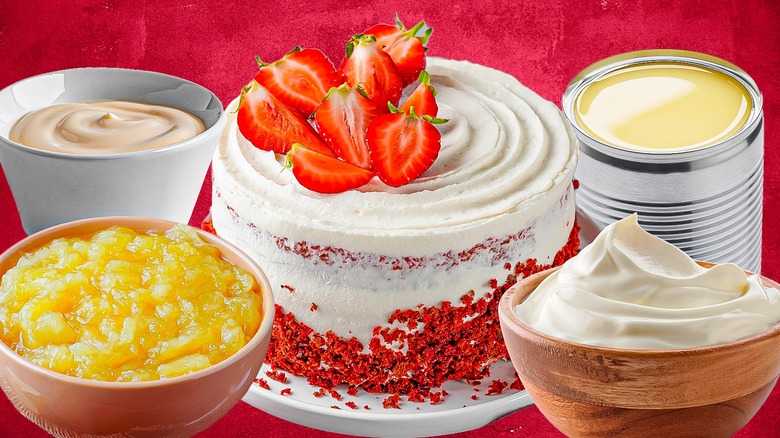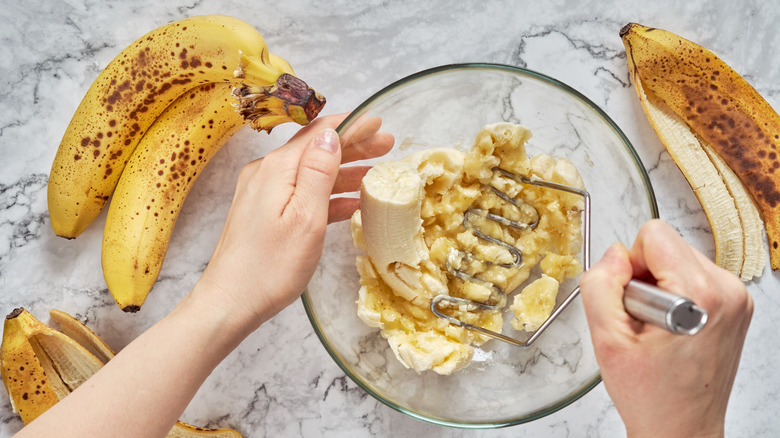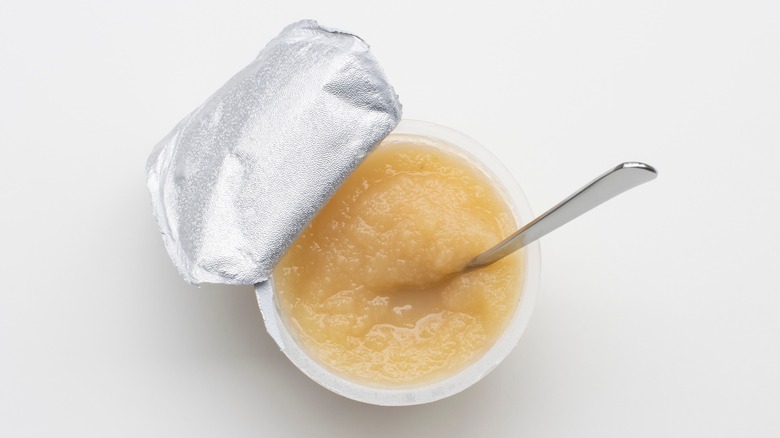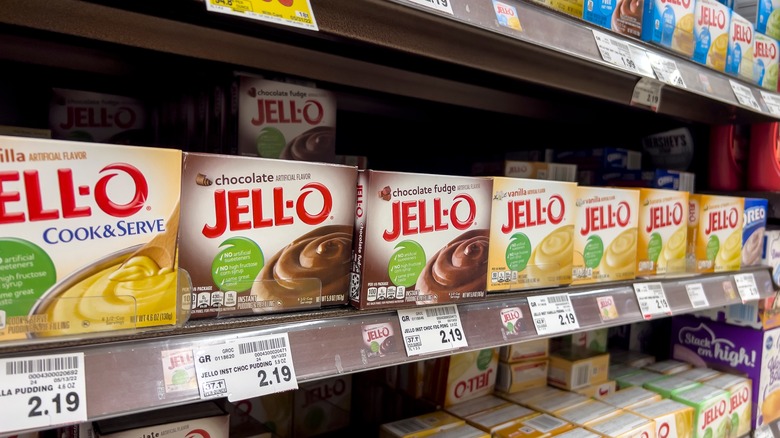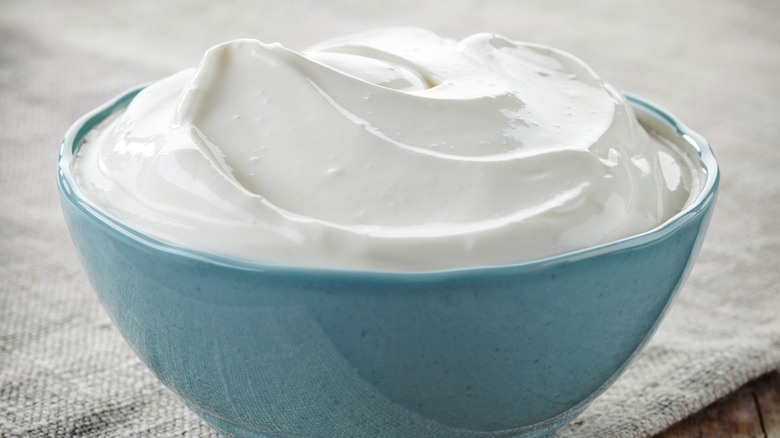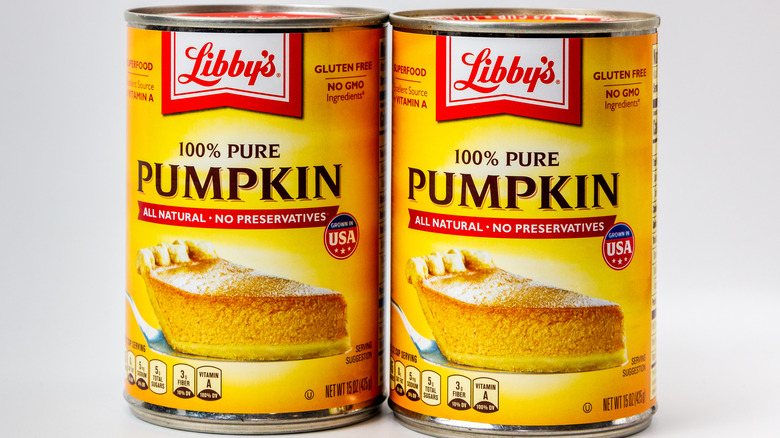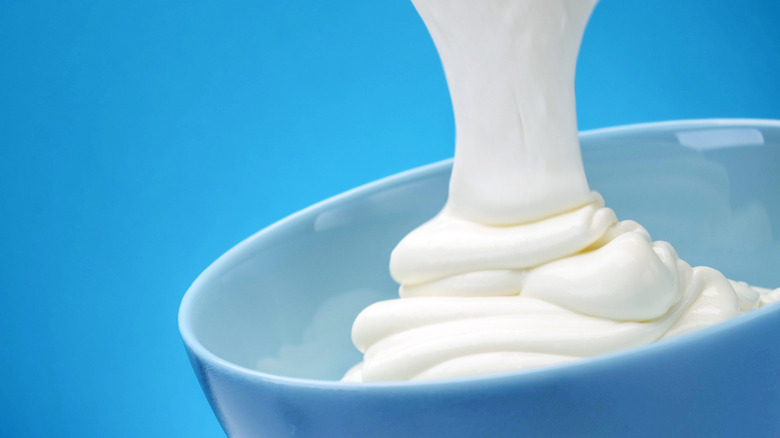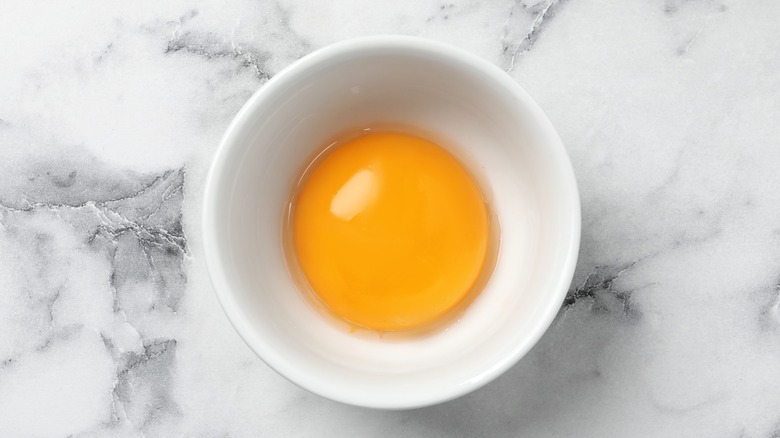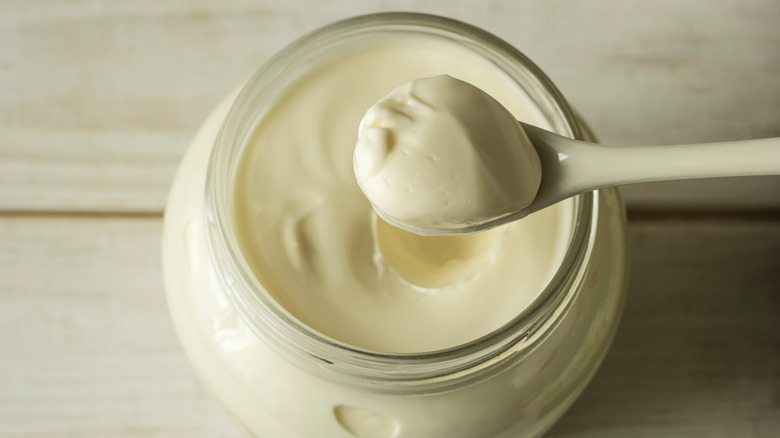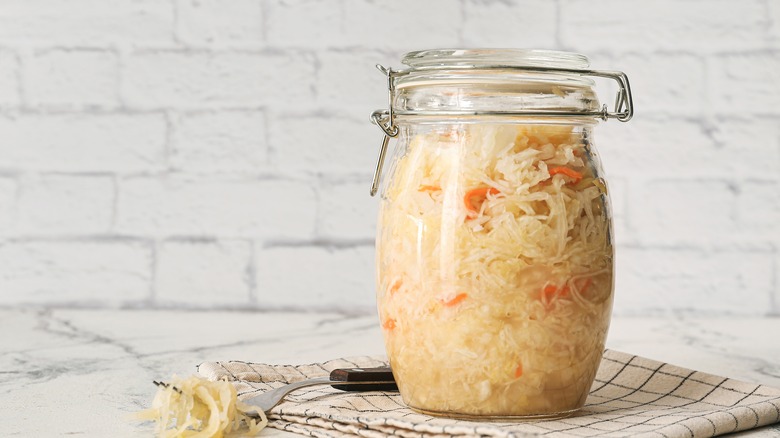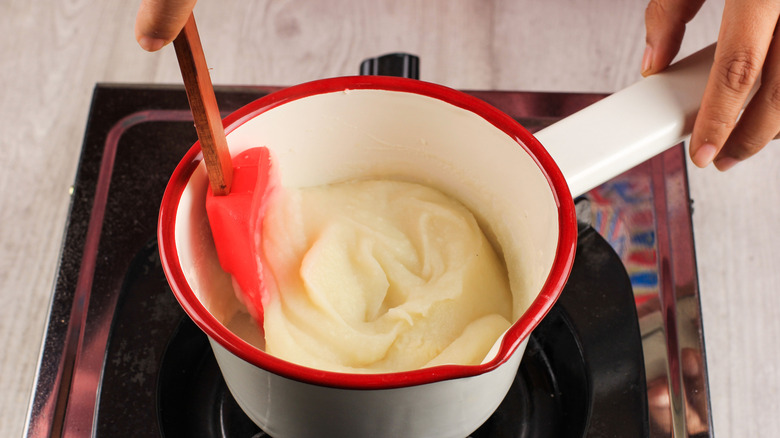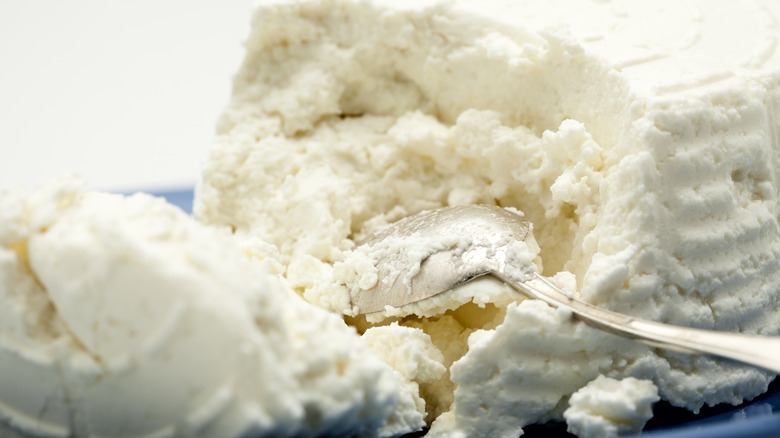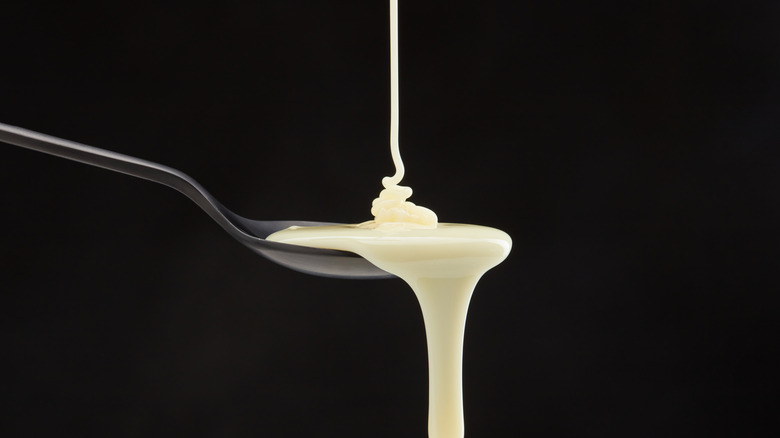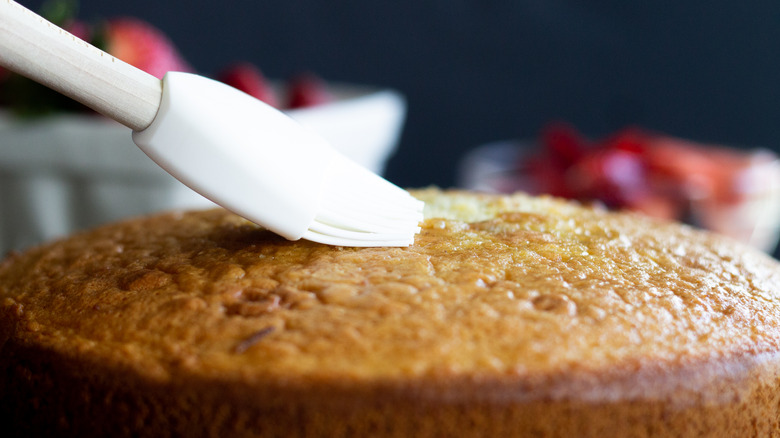14 Ingredients That Will Make Your Cake Extra Moist
It's an unfortunate but relatable situation when you spend so much time measuring, baking, leveling, and decorating a cake only to bite into it and find it to be dry and not as dreamy as you hoped. When the cake forms a layer on the roof of your mouth and becomes unpleasant to swallow, you know it's time to reevaluate your recipe or baking methods. Many cakes are indeed supposed to be dense and not necessarily airy, but that doesn't mean they can't be moist simultaneously.
Whichever kind of cake you make, there are simple ingredients you can add to the batter before you throw it in the oven, which help to lock in the moisture. These additions ensure that the cake is pleasantly soft not only when you remove it from the oven, but for hours and days afterward too. And, if you already have your cake in the oven, there is even a way to hydrate it after it bakes, so there is no chance of you ending up with a sweet treat that feels stale moments after you make it.
1. Bananas
If you are a fan of banana bread, you likely enjoy how tender it is; the bananas play a massive role in its texture, so you can create a similar feel when you add the mashed fruit to different kinds of cake. Ripe bananas are made of up to 80% water, so it's no wonder why they help produce extra soft baked goods. The only thing to consider is how ripe bananas taste strong — not many ingredients mask their fruity flavor. Hence, you should include them in cake batter that pairs well with them — think chocolate, peanut butter, or vanilla cake.
Also, when you use this addition, the cake has tiny specks from the fruit, which gives it some character. Use one or two bananas; the more you add, the more fudgy the cake's consistency will be. Mash the bananas separately to ensure there are no large lumps. It doesn't necessarily matter when you blend them into the batter. However, mixing them with wet ingredients is much easier than mixing them with dry ingredients.
2. Applesauce
Another fruity assistant that imparts moisture in cake is apples, or, more specifically, applesauce. The benefit when you use applesauce is that the apples are already mashed for you, unlike if you use bananas. Furthermore, you can experiment with variations like cinnamon or no-sugar-added applesauce, which change the flavor but don't lessen the product's effectiveness. Either way, the fruit has natural sugars, so it is compatible with sweet treats, especially fruity cakes.
Next time you make a cake, throw in some applesauce — one or two of the small single-portioned cups are plenty to achieve the result you're looking for. If your recipe uses the creaming method, add the applesauce with the butter, sugar, and eggs. Otherwise, fold it in as the last addition before you transfer the mixture to the baking pan. Although applesauce can replace oil or eggs entirely, we recommend you use it as an additional ingredient for improved hydration.
3. Instant pudding
Whether you want to upgrade your boxed cake mix or make an irresistible homemade cake, instant pudding helps you out. It is so trouble-free that you don't need to make the pudding before you add it to the batter; you can pour the granulated pudding mix directly into it. This might feel counterproductive — how will adding a dry ingredient make the cake wetter? First, don't fret, the granules dissolve into the other components, and it doesn't make the cake grainy. Secondly, the specific combination of ingredients in the pudding packet works magic to create dense yet soft desserts.
Most popular instant pudding brands contain sugar, modified cornstarch, xanthan gum, and other elements. The extra sugar in the pudding latches onto water molecules in the batter, which preserves the moisture. Meanwhile, the cornstarch pairs up with the flour; it makes the protein components less rough, and the cake's mouthfeel becomes more fudgy. You can put anywhere between 2 to 4 ounces of the mix into the dessert batter. The small packages at the grocery store are usually 3.4 ounces, so it works out perfectly to add one box for every cake you make.
4. Sour cream
Sour cream is an ingredient you probably have in your refrigerator. Although people usually use sour cream in savory instances, like with tacos or atop spicy soups, it also benefits sweet foods. No matter what kind of cake you make, whether a hefty pound cake or a colorful Funfetti birthday cake, sour cream moistens it, making it more luscious. Precisely, sour cream does wonders for chocolate cake because of its acidic and fatty nature, which works to retain moisture in the baked good and complement the chocolate. Don't worry about the subtle tanginess in the sour cream; it doesn't modify the cake's taste, so nobody will notice that you've included it.
Chocolate cake sometimes turns out dry because of the cocoa powder, but when you add roughly 1 cup of sour cream to the batter, it creates balance in the mixture. Even if you don't have a cup's worth, use a smaller amount of sour cream; any little bit helps. For recipes that require milk or buttermilk, stir it with the sour cream and add both at once to integrate them effortlessly.
5. Pumpkin puree
Everyone knows pumpkin puree has a relatively bright hue you can't ignore, so naturally, this addition is best for cakes where you can disguise it. For example, you can mix pumpkin puree in devil's food cakes or carrot cakes that have other prominent-looking ingredients. Furthermore, these types of cakes also have bold flavors like chocolate or spices, which tones down the pumpkin taste so that it doesn't take charge of the cake's flavor profile. Of course, if the inevitable color change is worth it for the improved consistency, you're more than welcome to use it in lighter-colored cakes too.
Canned pumpkin holds approximately 90% of water, so your cake turns out tender when you introduce pumpkin to the batter. For a normal-sized batch of cake batter, about ½ cup of the puree does the trick. Make the cake mixture as usual, then gently fold the pumpkin last to complete the batter before you bake it. If you want to add more, you certainly can; just don't go overboard because you don't want it to thin the batter too much.
6. Yogurt
Like sour cream, yogurt is a staple in many households, which makes it a convenient option. You can use any yogurt you have on hand, but Greek yogurt is wonderful since it is less runny than other kinds. In general, yogurt is acidic, which works to your advantage because the bitterness is subtle enough that it doesn't make the cake sour, but instead, it adds depth to its overall taste. Not to mention, if you use a recipe that requires baking soda, it boosts the leavening agent's abilities, which makes the cake ultra-fluffy too. Furthermore, yogurt's water and fat content is a significant reason why it is advantageous when you add it to the cake.
Specifically, Healthline reports that whole milk yogurt has 88% water and 3.3 grams of fat per every 3.5-ounce serving. When you use it to moisten your dessert, involve ¼ to ¾ cup with the milk or other liquid ingredients in the recipe. Another thing to keep in mind is the flavor of the yogurt. Plain or vanilla flavors are the prime choices because they're mild, but if you wish to get creative, use one that complements the cake you make. For instance, strawberry yogurt in a berry cake provides the baked good with a fruity taste and a pleasant consistency.
7. Extra egg yolks
Don't toss out any extra yolks you might have; their rich and fatty properties make for a lovely, soft cake. Yellow cake is the ultimate type to utilize this technique since the yolks bestow the batter with a gorgeous golden color. In addition, yolks have a buttery essence, which adds to the cake's richness. When you use this trick, you must realize that the yolks don't act as a substitute for the whites. If the recipe calls for whole eggs, add one or two additional yolks because otherwise, the dessert doesn't rise as much when it bakes, or its consistency becomes off.
So, the magic happens when you have an increased amount of fat in the mixture. And yes, you can toss extra yolks in with both the pre-made cake mix or from-scratch batter; just follow your recipe and blend them in with the pre-determined number of eggs the recipe suggests.
8. Mayonnaise
Although this addition sounds off-putting at first, the truth is that when you add mayonnaise to cake mix, it doesn't alter its sweet taste, so you can take a sigh of relief. When you think about it, mayo contains oil, whole eggs, and yolks, so it has plenty of fat, which makes the cake a joy to indulge in. When it comes to the other ingredients, like vinegar and salt, the sugar and other sweet components overpower them.
Mayonnaise is the secret ingredient if you want moist cake, and you only need ½ cup to see a noticeable difference in your dessert's quality. However, since it has some heavy ingredients, it means that it does make the cake less airy in some cases, which is the only downfall. So, butter cakes are perfectly ideal, but not so much angel food cake. Generally, it isn't so detrimental that it makes folks weary of using it; grandmothers have used this hack for ages. Add it in with the wet ingredients, and you'll have success.
9. Sauerkraut
For a creative twist, add sauerkraut to your chocolate cake batter because it introduces more liquid and flavor to the dessert. This add-in is unique because rather than seamlessly blending with the other cake components, it stands out in the best way possible. Sauerkraut is not a smooth ingredient like yogurt; it can be pretty chunky and sour. But if you want your cake to be soft to the bite and you're up for dimensions of flavor, this is the right choice for you.
Believe it or not, there are sauerkraut cakes where it is used in large amounts, but you don't need to make it a primary ingredient if you don't want to. Instead, we suggest you incorporate a small amount into chocolate cake, where the chocolaty elements harmonize with and reduce the vegetal taste in the sauerkraut. Additionally, the cabbage pieces take on a texture similar to coconut or carrot strands in carrot cake, so it isn't so odd that it prevents people from enjoying it.
10. Mashed potatoes
Yes, you're not imagining it: Mashed potatoes are one of the unexpected ingredients that upgrade your cake. Before you rule this option out, it isn't the savory mashed potatoes you are likely thinking of; they're not chock-full of butter, salt, cream, or other seasonings. Instead, you boil plain potatoes and mash them as you do with bananas — nothing else included. So, no worries, your dinner party cake isn't going to taste like garlic and chives. It's a good thing potatoes are quite bland on their own.
If you plan to use this method, make the mashed potatoes homemade; you only need 1 medium to large-sized potato for each cake you make. Since they're mostly water and starch, it works as a binding agent and hydrating element for the batter. We don't recommend instant mashed potatoes, although that is much quicker and less troublesome. However, instant mashed potatoes often have other ingredients and don't contain the same amount of moisture as fresh mashed potatoes, so it doesn't produce the same result.
11. Ricotta
Ricotta's taste is far from pungent; it is creamy and has sweet notes to it, which makes it ideal to use in baked goods. Many people make ricotta fillings, frostings, or cheesecakes, where the flavor of the cheese is noticeable. But when you use it for added moisture in cakes, it is usually disguised by other components like sugar or chocolate. For the best outcome, don't add the ricotta cheese to your recipe too soon, but instead, add it last so that you don't overmix it; fold it in by hand to gently incorporate it into the batter.
For a standard recipe that makes one or two cakes, you can start with 4 ounces of cheese. Add more if you wish, but continuously observe the batter's appearance and consistency to ensure it doesn't dramatically change. It is normal for it to make chocolate cake batter a smidge lighter, but it shouldn't make it look milky.
12. Condensed milk
Folks use condensed milk in baking for its sweet and velvety properties. For example, tres leches, a popular soaked cake, includes condensed milk as one of the three kinds of milk used to soak the cake. But have you ever considered adding it directly to the batter for other cakes? It is a perfect way to add moisture to the mixture without making it overly watery because the condensed milk is thick. Not to mention, it's tasty, so it teams up with the other ingredients to create an enticing dessert.
If you want to experiment with this add-in, there is no set amount to use; start with ½ cup, and if you feel it's not enough, you can add more. You shouldn't need more than one 14-ounce can, though (which is how companies often sell condensed milk at the grocery store). Moreover, those condensed milk cans are 14 ounces in weight, not 14 fluid ounces, so it is something to keep in mind; transfer it to a measuring cup, to be precise. Add condensed milk to your boxed cake mix, and you'll notice how the cake remains fresher for longer because the condensed milk prevents it from losing its moisture.
13. Alcohol
Alcohol positively affects cakes and their mouthfeel when you add the right amount to your batter before it goes through the baking process. For instance, Martha Stewart adds brandy to her pound cake, which benefits its consistency and flavor depth. To be specific, Stewart includes Armagnac in her pound cake. Furthermore, it isn't uncommon for home bakers to supplement their sponge cake (a foam cake, much different than pound cake) with various types of alcohol for the same reasons. Whether you make a German chocolate cake or an extravagant strawberry shortcake, you don't need much alcohol to play its part in the cake base.
There are recipes where alcohol is replaced with some of the other fluid ingredients in the formula, like milk or coffee. But if you don't want an extremely boozy dessert, you can swap alcohol for baking extracts, like vanilla, and the taste is less in-your-face. And, of course, you don't have to use brandy as Stewart does; any type of alcohol you use alters the crumb of the dessert. You just have to worry about choosing one you like the taste of.
14. Simple syrup
Lastly, whether or not you add ingredients to the batter to make the cake pleasantly soft, simple syrup is always a foolproof way to ensure your cake doesn't dry out. Beginner bakers might not be familiar with simple syrup; to make it, you boil water and sugar to make a thick, sweet liquid. It is deemed simple because you make it with equivalent amounts of granulated sugar and water. Once the syrup cools some, you apply it to the baked cake to hydrate it. Some bakers place the mixture into a bottle and drizzle it onto the cakes. Meanwhile, you can also simply brush it onto the surface of the cake, and it dribbles down into the center.
There are plenty of ways to alter simple syrup to take on other flavors, too. You can do this by incorporating another ingredient after it comes off of the stovetop. For instance, adding lemon or orange extract can make a citrus variation. Then, when you soak the cake, it takes on a slight citrus flavor. However, it doesn't stop there; you can use any extract, such as peppermint, vanilla, almond, or coconut.
